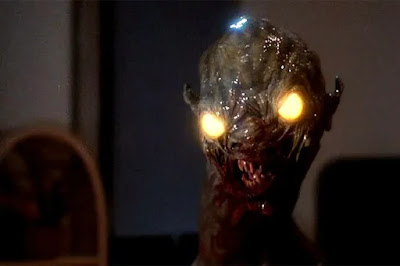Several highfalutin' New York theater actors, playwrights, and producers were at a party in the early '80s and started goofing on the idea of making a cheap horror movie. The half-serious idea built up steam as the party continued, and, long story short, C.H.U.D. became a reality. Noted C.H.U.D. skeptic Joe Bob Briggs feels the movie doesn't really work because the actors and filmmakers are slumming in a genre they don't entirely respect. I can sympathize with that take, and there are moments in the film where a horror lover's touch would have improved things, but C.H.U.D. is a solid, well-acted, and enjoyable '80s monster movie. And C.H.U.D. is just fun to say.
Because of its New York theater/indie film scene origins, C.H.U.D. is packed with early roles for people who would go on to long careers as well-known character actors. The two male leads, John Heard and Daniel Stern, had already established themselves in film alongside their theater work, but most of the cast were making their film debuts or had only a handful of prior film roles (though most were theater veterans), including Kim Greist, Christopher Curry, Sam McMurray (memorably appearing in Raising Arizona a few years later), Vic Polizos, Graham Beckel, Bill Raymond, Peter Michael Goetz, Jay Thomas, Jon Polito, and, last but not least, John Goodman. I even blinked and missed small parts for Frankie Faison and Patricia Richardson. If most of these names are unfamiliar to you, type them up in the image search of your choice and you'll probably know their faces from dozens of movie and TV roles.
C.H.U.D. was filmed all over (and under) NYC (and a bit of Jersey City), with the bulk of shooting in the SoHo neighborhood of Manhattan shortly before its gentrified transformation into expensive residences and high-end shopping for the affluent. C.H.U.D. is a sweaty, grimy, dirty movie, and the filmmakers succeed admirably at avoiding any New York glitz and glamor. They also avoid sleaze, focusing exclusively on grit, dirt, and dank. (Imagine C.H.U.D. in Odorama or Smell-O-Vision.) For a deep dive into the film's locations, I highly recommend this post.
For a cheap monster movie, C.H.U.D. was ahead of the times in treating homelessness and environmental issues as interconnected crises. A segment of the NYC homeless population living near the subway tunnels and sewers underneath the city (see the documentary Dark Days for part of the real-life inspiration) has been disappearing. This mystery is worrying two men who don't yet know each other, photographer George Cooper (John Heard), whose day job is in fashion photography but who has been taking pictures of his neighborhood's homeless people as part of an art photo/photojournalism hybrid project, and A.J. "The Reverend" Shepherd (Daniel Stern), an activist who runs a neighborhood soup kitchen. George can't find any of the undergrounders he's been photographing and therefore can't finish his project, and none of them (except for crazy, knife-wielding Val) have shown up at A.J.'s soup kitchen for three weeks. Meanwhile, the EPA and the NRC are up to something in the underground, and they're being mighty secretive about it. What are they hiding? That's right. Chuds. Does C.H.U.D. stand for "cannibalistic humanoid underground dweller" or "contamination hazard urban disposal"? Oh shit. Maybe both?
The cops finally start sniffing around the mystery when the housed population begins disappearing. Police captain Bosch (Christopher Curry) is especially adamant about getting to the bottom of all these disappearances after his wife goes missing. He forms an initially uneasy alliance with A.J. after running into secrecy and bureaucracy at the top but turns into a chud-fighting crusader who gets things done. The characters love saying Bosch's name, probably because it's almost as fun to say as "chud." Try it. "Hey, Bosch!" "Forget it, Bosch." "Come on, Bosch!" The dialogue is full of phrases like this. My particular favorite is when an exasperated A.J. says, "It doesn't wash, Bosch." If I were on the writing team, I'd have snuck in, "You've gone too far this time, Bosch," or "Bosch just blasted a chud!" but you can't have everything.
Other important characters include George's girlfriend Lauren (Kim Griest), a model who can hold her own in a chud attack, Mrs. Monroe (avant-garde theater vet Ruth Maleczech), a homeless woman living in the underground whose brother was attacked by a chud, and Wilson (George Martin), an official from the NRC who is covering up the secret dumping of toxic waste.
Things reach the breaking point when chuds attack a diner, rudely before a couple of cops played by John Goodman and Jay Thomas get to enjoy their cheeseburgers. The bloodbath brings out the cops, government officials, most of the main characters, and a bunch of neighborhood extras, and unites George and A.J. at last. (They would appear together again, on opposite sides of the law this time, in Home Alone, a movie that could have used a chud or two in my opinion.) Crisis finally averted, the chuds would remain quiet until 1989's C.H.U.D. II: Bud the C.H.U.D., which will have to wait for a future post.
The film, surprisingly director Douglas Cheek's only feature (he mostly works as a film editor), is a bit light on blood, guts, and full-on mayhem, and the chud effects are a little cheap (though I have to remark on how jacked the chuds are; they must have been blasting their quads and doing a bunch of Internet yoga videos taught by rich influencer women who love inspirational quotes; their neck muscles are insane), but the acting is obviously good, the story is well-paced, the suspense scenes work, and it's all pretty fun. I mildly urge you to enter the chudniverse.











No comments:
Post a Comment